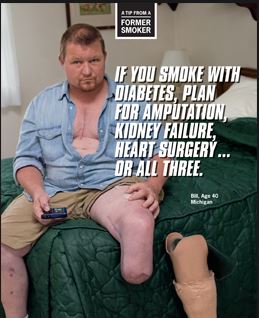Fifty percent of smokers attempt to quit every year through various means (CDC, 2011). Previous research suggests that highly emotional antismoking ads with personal stories or graphic imagery can be effective in getting people to quit (Dunlop, Cotter & Perez, 2013), though not consistently (Addiction & The Humanities, 8(8)). For 3 months last year, the U.S. Centers for Disease Control and Prevention (CDC) ran a national multi-media anti-smoking campaign called “Tips from Former Smokers” (“Tips”). The campaign, which cost $54 million dollars, featured graphic advertisements showing the effect of smoking-related illness on individuals’ lives. This week, ASHES reviews a study that investigated the effects of Tips on national smoking quit attempts (McAfee et al., 2013).
Method
- Researchers invited a randomly selected, nationally representative online panel to participate in the online survey. This review reports on the 3,051 participants who completed baseline and follow-up assessments and were current smokers at baseline. Participants completed the baseline survey one month before the Tips campaign began, and completed the follow-up survey immediately after the campaign finished.
- In terms of response and retention rates, 4,108 (70%) of 5,903 invited smokers completed the baseline survey, and 3,051 (74%) of those completed the follow-up survey.
- The researchers measured quit attempts and campaign awareness:
- A quit attempt was defined as abstaining from smoking cigarettes for 1 day or longer.
- Tips campaign awareness, assessed only at follow-up, was measured by showing television advertisements and asking participants how often they had seen each advertisement
during the past 3 months.
Results
- The number of smokers reporting a quit attempt in the past 3 months increased by 12%, from 31.1% (95% Confidence Interval (CI) [30.3% – 31.9%]), before the Tips campaign began to 34.8% (95% CI [34.0% – 35.7%] after it ended.
- Overall, 2,395 (78%) smokers recalled seeing at least one Tips advertisement on television. People who reported at follow-up having seen the Tips advertisements were more likely
to report making a quit attempt, odds ratio (OR) = 1.18, 95% CI[1.05-1.34]. - Applying the change rates in the cohort to national census data suggests that an estimated 1.64 million US smokers attempted to quit during the Tips campaign.

Figure. Example of a Tips Advertisement. (From CDC “Tips from Former Smokers” website, http://www.cdc.gov/tobacco/campaign/tips/resources/videos/) Click image to enlarge.
Limitations
- The study only looked at short-term campaign effects. People might have stopped smoking after the three-month follow-up or failed to maintain cessation after their quit attempt.
- Only slightly more than half of all invited smokers completed both baseline and follow-up surveys, raising the possibility of selection bias within the sample.
- It is possible that factors other than the Tips campaign (e.g., time of year) might have affected the quit-attempt rate. However, the finding that people who reported having seen the Tips advertisements were more likely to report making a quit attempt at follow-up provides support for the idea that the Tips campaign increased the number of quit attempts.
Discussion
The study’s results suggest that graphic national anti-smoking campaigns might generate some population-level public health benefits. People who viewed emotionally-stirring warnings about the disturbing effects of smoking on health were more likely to try quitting smoking. This puts media campaigns within the cadre of other successful public health interventions. Future studies could examine how long the campaign effects last, and which factors, if any, contribute to decline in smoking attempts after the three-month period.
— Kat Belkin
References
CDC (2011). Quitting smoking among adults: United States, 2001–2010. Morbidity and Mortality Weekly Report, 60: 1513–19.
Dunlop, S.M., Cotter, T., Perez, D. (2013). When your Smoking is not just about you: Antismoking advertising, interpersonal pressure, and quitting outcomes. Journal of Health Communication: International Perspectives; 1-16
McAfee, T, Davis, KC, Alexander Jr, RL, Pechacek, TF, Bunnell, R. (2013). “Effect of the first federally funded US antismoking national media campaign.” The Lancet, Sep 9, 2013.
What do you think? Please use the comment link below to provide feedback on this article.




